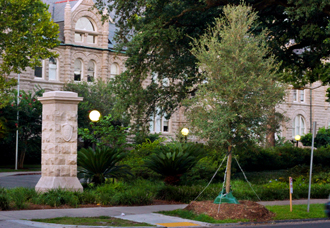Live Oaks Live
Tulane University has contributed three new live oaks to a tree-planting project along the St. Charles Avenue streetcar line. The three trees have been planted this summer in the block in front of Gibson Hall.

Tulane has contributed to the largest planting along the historic St. Charles Avenue streetcar line since the 1880s by planting three live oak trees in front of Gibson Hall. (Photo by Guillermo Cabrera-Rojo)
After four challenging years of fund raising and two successful seasons of planting, New Orleans lawyer Frederic Theodore “Ted” Le Clercq is looking forward to the anniversary of Hurricane Katrina, when he hopes the 250th live oak tree will be planted.
Le Clercq, whose wife, Courtney Johnson Le Clercq, received an MBA from Tulane in 1996, conceived and headed the project because he wanted to do something to revitalize and boost perceptions about the city, post-Katrina. He walked the historic avenue raising money from businesses and citizens, and seeking agreement for planting the trees.
“Celebrated by tourists and locals alike, St. Charles Avenue has been ranked among the 10 greatest streets in America,” says Le Clercq, an employment and professional liability defense attorney with local law firm Deutsch, Kerrigan and Stiles. “Live oaks are a symbol of St. Charles Avenue and of our city they grace the avenue with beauty, they cause a cooling effect during our many hot months, and they increase business by attracting people to the avenue.”
The novel private/public partnership has resulted in the St. Charles Avenue streetcar line being planted from Lee Circle downtown to the corner of Carrollton and Claiborne Avenues. All contributions to the project are tax-deductible, says Le Clercq.
Le Clercq lauded Tom Armitage, superintendent of grounds at Tulane, as a “good steward for Tulane property and land. He is a great advocate for the beauty of the campus."
The three new Tulane trees, each about 16 to 18 feet tall and with trunks that are six inches diameter, join the 209 live oak trees growing on the Tulane uptown campus, Armitage says.
